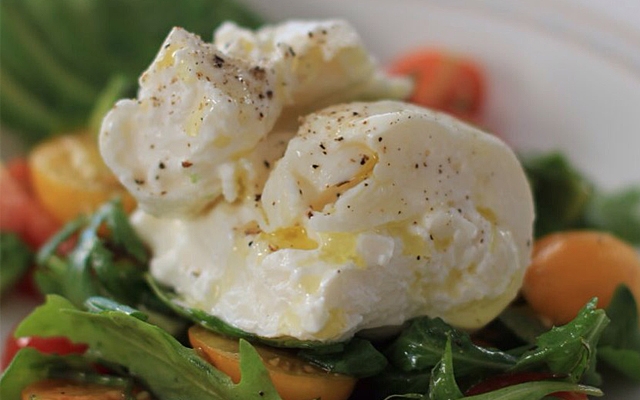I can tell that summer has arrived, even if the weather isn’t entirely cooperating.
It’s not because Vancouverites have bravely been wearing shorts for weeks now, or that there has been a flood of visitors standing around the steam clock every time I drive through Gastown. The reason I am positive summer has arrived is that the number of customers calling to check on our stock of burrata has increased tenfold since May.
Once the summer weather warms up and BBQ season begins in earnest, all cheese minded people start to imagine picnic tables laden with platters of delicious summery dishes made with burrata. Grilled country bread drizzled with olive oil and burrata? Yes! Plates of cool prosciutto and ripe olives topped with torn chunks of burrata? Yes again. Something about all the lovely vegetables at the famers market in the summer make us want to eat lighter, and the burrata with its delicate flavours seem to compliment all of those fresh tastes without overwhelming them.
Burrata has been made in the region of Puglia, Italy since the early 1900’s. The cheese is made with an outer shell of hand stretched fresh mozzarella that is filled with torn mozzarella and cream. The cheese is shipped in water, like a Mozzarella di Bufala. However unlike the bufala, you can’t really cut burrata. Once you cut into it, the centre tries to escape, so it is best to have your dish ready ahead of time.
I would suggest that you prepare whatever delectable dish you are dreaming of, and once it is all ready to go, open your container of Burrata. As it comes in water, I usually pat it dry on a paper towel to rid it of any excess liquid. Then quickly cut it, or tear it into chunks and garnish your platter with it. I love to add it to a plate of barbequed vegetable, like zucchini, peppers and eggplant. The lovely shine of the outer shell of the cheese lights up the colourful veggies, and it only needs some salt, fresh pepper and a drizzle of good olive oil, tp make it a perfect summer meal.
All Italian burrata comes to Canada by air, unlike most other cheese that arrives by boat. The perishable nature of the cheese means it has to arrive as quickly as possible and even then, it doesn’t have a long life. Most importers have fresh Italian cheese arriving every two weeks, so there are often a few days in between shipments when stocks run low. Due to its perishable nature and its dependence on tricky shipping, it isn’t a particularly dependable product, so look for it when the craving hits you, and pray you can find it. There are some versions made in Canada and California as well, although I personally like the Italian one best. Find your neighbourhood source now so you'll be ready for your next summer barbeque.

 quicksearch
quicksearch






